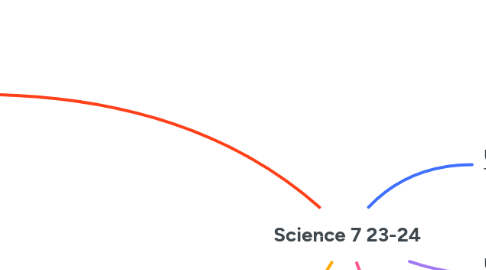
1. Unit 2 The Changing Earth
1.1. Module 1 Dynamic Earth
1.1.1. Lesson 1 Moving Continents
1.1.1.1. Pangaea
1.1.1.2. Continental Drift
1.1.1.3. Rock Formation Evidence
1.1.1.4. Glacial Features Evidence
1.1.1.5. Coal Deposit Evidence
1.1.1.6. Fossil Evidence
1.1.1.7. Alfred Wegener
1.1.2. Lesson 2 Development of a Theory
1.1.2.1. Ocean Floor Topography
1.1.2.2. Mid-Ocean Ridges
1.1.2.3. Ocean Trenches
1.1.2.4. Isochron Maps
1.1.2.5. Seafloor Spreading
1.1.2.6. Magma
1.1.2.7. Lava
1.1.2.8. Plate Tectonics
1.1.3. Lesson 3 Shaping Earth's Surface
1.1.3.1. Convergent Boundary
1.1.3.2. Divergent Boundary
1.1.3.3. Transform Boundary
1.1.3.4. Fold Mountains
1.1.3.5. Subduction
1.1.3.6. Fault
1.1.3.7. Fault-Block Mountains
1.1.3.8. Volcano
1.1.3.9. Volcanic Arc
1.1.3.10. Earthquake
1.1.3.11. Fault Zone
1.1.3.12. Landslide
1.1.3.13. Tsunami
1.1.3.14. Impact Craters
1.1.4. Lesson 4 Changing Earth's Surface
1.1.4.1. Physical Weathering
1.1.4.2. Frost Wedging
1.1.4.3. Plant Action
1.1.4.4. Abrasion
1.1.4.5. Wind Abrasion
1.1.4.6. Water Abrasion
1.1.4.7. Glacial Abrasion
1.1.4.8. Chemical Weathering
1.1.4.9. Oxidation
1.1.4.10. Hydrolysis
1.1.4.11. Carbonation
1.1.4.12. Erosion
1.1.4.13. Deposition
1.1.4.14. Small Scale Erosion
1.1.4.15. Surface runoff
1.1.4.16. Coastal Erosion
1.1.4.17. Large Scale Erosion
1.1.4.18. Mass Wasting
1.1.4.19. Glacial Movement
1.1.5. Lesson 5 The Cycling of Earth's Materials
1.1.5.1. Rock
1.1.5.2. Mineral
1.1.5.3. Crystallization
1.1.5.4. Igneous extrusive rock
1.1.5.5. Igneous intrusive rock
1.1.5.6. Sedimentary rock
1.1.5.7. Lithification
1.1.5.8. Compaction
1.1.5.9. Cementation
1.1.5.10. Metamorphic rock
1.1.5.11. Rock Cycle
1.2. Module 2 Natural Hazards
1.2.1. Lesson 1 Earthquakes
1.2.1.1. Earthquakes and Plate Boundaries
1.2.1.2. Richter Magnitude Scale
1.2.1.3. Earthquake Magnitude
1.2.1.4. Moment Magnitude Scale
1.2.1.5. Modified Mercali Intensity Scale
1.2.1.6. Structural Failure
1.2.1.6.1. Pancaking
1.2.1.6.2. Building Height
1.2.1.7. Liquefaction
1.2.1.8. Landslide
1.2.1.9. Tsunami
1.2.2. Lesson 2 Volcanoes
1.2.2.1. Volcano Belts
1.2.2.2. Hot Spots
1.2.2.3. Volcanic Hazard
1.2.2.3.1. Mudflows
1.2.2.3.2. Lava flows
1.2.2.3.3. Volcanic ash
1.2.2.3.4. Volcanic gases
1.2.2.3.5. Landslides
1.2.2.3.6. Pyroclastic flows
1.2.2.4. Predicting Volcanoes
1.2.2.4.1. Gas
1.2.2.4.2. Deformation
1.2.2.4.3. Ground Vibration
1.2.2.4.4. Remote Sensing
1.2.2.4.5. Lava Collection
1.2.3. Lesson 3 Severe Weather
1.2.3.1. Hurricane
1.2.3.2. Saffir-Simpson Hurrican Scale
1.2.3.3. Tornado
1.2.3.4. Enhanced Fujita Damage Intensity Scale
1.2.3.5. Flood
1.2.3.6. Drought
1.2.3.7. Drought Hazards
1.2.3.7.1. Soil Erosion
1.2.3.7.2. Wildfires
1.2.3.7.3. Decrease in Water Supply
1.2.3.7.4. Agricultural Impact
1.2.3.8. Meteorologist
2. Unit 1 Understanding Matter
2.1. Module 1 Classification and States of Matter
2.1.1. Lesson 1 Energy and States of Matter
2.1.1.1. Matter
2.1.1.2. Solid State
2.1.1.3. Liquid State
2.1.1.4. Gas State
2.1.1.5. Kinetic Energy
2.1.1.6. Temperature
2.1.1.7. Thermometer
2.1.1.8. Kelvin Scale
2.1.1.9. Potential Energy
2.1.1.10. Thermal Energy
2.1.1.11. Atom
2.1.1.12. Substance
2.1.1.13. Element
2.1.1.14. Compound
2.1.1.15. Molecule
2.1.1.16. Periodic Table of Elements
2.1.1.17. Element Symbols
2.1.1.18. Chemical Formula
2.1.2. Lesson 2 Changes in Temperature
2.1.2.1. Thermal Contraction
2.1.2.2. Jacques Charles
2.1.2.3. Thermal Expansion
2.1.2.4. Volume-Temperature Law
2.1.2.5. Heating
2.1.2.6. Pressure
2.1.2.7. Melting
2.1.2.8. Melting Point
2.1.2.9. Vaporization
2.1.2.10. Boiling Point
2.1.2.11. Evaporation
2.1.2.12. Freezing
2.1.2.13. Condensation
2.1.2.14. Systems
2.1.2.15. Phase Change
2.1.2.16. Boiling vs Evaporation
2.1.3. Lesson 3 Changes in Pressure
2.1.3.1. Robert Boyle
2.1.3.2. Boyle's Law
2.1.3.3. Pressure & Number of Particles
2.1.3.4. Relationships
2.1.3.4.1. Pressure/Volume
2.1.3.4.2. Pressure/Number of Particles
2.1.3.4.3. Pressure/Temperature
2.1.3.5. Pressure & State of Matter
2.1.4. Lesson 4 Molecular Structure
2.1.4.1. Molecule
2.1.4.2. Nonmetal Gases
2.1.4.3. Nonmetal Solids
2.1.4.4. Metal
2.1.4.5. Ionic Compounds
2.1.4.6. Covalent Compounds
2.1.4.7. Polar Covalent Compounds
2.1.4.8. Nonpolar Covalent Compounds
2.1.4.9. Dissolving
2.2. Module 2 Matter: Properties and Changes
2.2.1. Lesson 1 Properties of Matter
2.2.1.1. Qualitative Characteristics
2.2.1.2. Quantitative Characteristics
2.2.1.3. Mass
2.2.1.4. Weight
2.2.1.5. Volume
2.2.1.6. Density
2.2.1.7. Physical Properties
2.2.1.8. Chemical Properties
2.2.1.9. Flammability
2.2.1.10. Solubility
2.2.1.11. Oxidation
2.2.1.12. Reactivity
2.2.1.13. Conductivity
2.2.2. Lesson 2 Property Changes in Chemical Reactions
2.2.2.1. Chemical Change
2.2.2.2. The Law of Conservation of Mass
2.2.2.3. Antoine Lavoisier
2.2.2.4. Chemical Reaction
2.2.2.5. Chemical Equations
2.2.2.6. Atomic Mass
2.2.2.7. Reactants
2.2.2.8. Products
2.2.2.9. Coefficient
2.2.2.10. Stoichiometry
2.2.2.11. Subscript
2.2.3. Lesson 3 Energy Changes in Chemical Reactions
2.2.3.1. Chemical Potential Energy
2.2.3.2. Endothermic Reactions
2.2.3.3. Exothermic Reaction
2.2.3.4. Law of Conservation of Energy
2.2.3.5. Concentration in Reactions
3. example for shane
3.1. example 1
3.2. example 2
3.3. example 3
3.4. example 2
4. Unit 4 Interactions with Ecosystems
4.1. Module 1 Matter and Energy in Ecosystems
4.1.1. Lesson 1 Photosynthesis and Cellular Respiration
4.1.1.1. Photosynthesis
4.1.1.2. Epidermal leaf cells
4.1.1.3. Cuticle
4.1.1.4. Stomata
4.1.1.5. Mesophyll Cells
4.1.1.6. Chloroplasts
4.1.1.7. Chlorophyll A and B
4.1.1.8. Light Cycle
4.1.1.9. Night Cycle
4.1.1.10. Different sugars
4.1.1.11. Cellular Respiration
4.1.1.12. Glycolysis
4.1.1.13. Mitochondria
4.1.1.14. Lactic Acid Fermentation
4.1.1.15. Ethanol Alcohol Fermentation
4.1.2. Lesson 2 Flow of Energy
4.1.2.1. Producers
4.1.2.2. Consumers
4.1.2.2.1. Primary Consumer
4.1.2.2.2. Secondary Consumer
4.1.2.2.3. Tertiary Consumer
4.1.2.3. Detritivores
4.1.2.4. Food Chain
4.1.2.5. Food Web
4.1.2.6. Energy Pyramid
4.1.3. Lesson 3 Cycling of Matter
4.2. Module 2 Dynamic Ecosystems
4.2.1. Lesson 1 Resources in Ecosystems
4.2.2. Lesson 2 Interactions Within Ecosystems
4.2.3. Lesson 3 Changing Ecosystems
5. Unit 3 Earth's Resources
5.1. Module 1 Distribution of Earth's Resources
5.1.1. Lesson 1 Natural Resources
5.1.1.1. Natural Resource
5.1.1.2. Energy Resource
5.1.1.2.1. Sunlight
5.1.1.2.2. Fossil Fuels
5.1.1.2.3. Renewable Energy
5.1.1.3. Land Resource
5.1.1.3.1. Wood
5.1.1.3.2. Living Space
5.1.1.3.3. Wilderness Preservation
5.1.1.3.4. Ore
5.1.1.3.5. Air
5.1.1.3.6. Water
5.1.1.4. Nonrenewable Resource
5.1.1.5. Renewable Resource
5.1.2. Lesson 2 Distribution of Resources
5.1.2.1. Hydrothermal deposits
5.1.2.2. Subduction Zones
5.1.2.3. Distribution of minerals
5.1.2.4. Soil
5.1.2.5. 5 Factors of soil formation
5.1.2.6. Formation of Coal
5.1.2.7. Formation of Oil and Natural Gas
5.1.2.8. Porosity
5.1.2.9. Permeability
5.1.2.10. Groundwater
5.1.2.11. Groundwater distribution
5.1.3. Lesson 3 Depletion of Resources
5.1.3.1. Mining
5.1.3.2. Dwindling Deposits
5.1.3.3. Mineral Supplies
5.1.3.4. Fossil fuel extraction
5.1.3.5. Groundwater overdraft
5.2. Module 2 Materials Science
5.2.1. Lesson 1 Synthetic Technology
5.2.1.1. Material
5.2.1.2. Natural Material
5.2.1.3. Synthetic Material
5.2.1.4. Reactants to Products
5.2.2. Lesson 2 Synthetic Materials and Societal Impacts
5.2.2.1. Natural Resource Availability
5.2.2.2. Synthetic Material Production
5.2.2.3. Individual and Societal impacts
5.2.2.4. By-products
